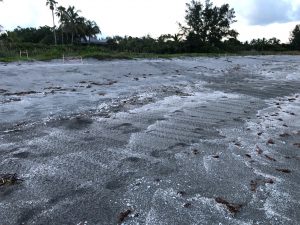As an Environmental Education and Outreach Intern for the Ecology and Natural Resource Program at UF/IFAS Extension Sarasota County, I was afforded the opportunity to engage with our flora and fauna in ways I never had before. After some late nights and early mornings, sea turtles — an order of animals (Testudines) I had always appreciated — and their ardent conservationists took on a whole new meaning. Read more about my experience and how you can help our sea turtles!
Sarasota’s Sea Turtles
Worldwide, there are 7 different species of sea turtle, 5 of which can be found in the Gulf of Mexico. While the loggerhead and green sea turtles are the two most common found on Sarasota’s 35 miles of beaches, leatherbacks, hawksbills, and the kemp ridley sea turtle may frequent our shores as well.

Conservation Status
One of the most astonishing things about sea turtles is their diminishing populations. Due to hunting and the inherent difficulties of reproduction for a species only becomes sexually mature at around 20 years of age and has plentiful obstacles to maturation, all are considered threatened with extinction. Leatherbacks and loggerheads are deemed “vulnerable”, the green sea turtle “endangered”, and the hawksbill and Kemp’s ridley “critically endangered”.
Because of the vulnerability of all sea turtle species, Sarasota County, Mote Marine Laboratory, and Florida Fish and Wildlife Conservation Commission’s Sea Turtle Program all work to collect sea turtle nesting data and tag individuals.
Sea Turtle Surveying
The entirety of nesting season runs from May 1st to October 31st. This is done by volunteers acting selflessly in the name of science to save sea turtle populations.
My Experience

From 9pm to 4am, I helped patrol the 10 miles of Sarasota’s Manasota beach. We donned red-light headlamps and headed for the beach to insert micro-chips, tag, take carapace (shell) measurements and record information about the time of day, tides, distance from the water, and more.
In the span of seven hours, we tagged 11 loggerheads and 2 greens — especially exciting finds — with more turtles making their way onto the stretch of beach to whom we couldn’t tend. And simply stated, it was miraculous. The trance-like state of these sea dwelling animals making their way on land was awe inducing. They navigate the world’s oceans to return to the beach of their birth and lay nests of their own, instinctually know how to excavate the perfect cavity and abort the mission should something feel off. It’s an extraordinary feat of nature.
But, as I grew more appreciative of this feat of nature, I became more depressed by the idea that it’s a dying art. Despite the efforts of volunteers, sea turtle populations remain imperiled. While the efforts of some individuals in collecting data and rescuing stranded individuals is impressive, it will take collective buy-in to preserve sea turtle populations.
Hatchling Patrol
On the other end of sea turtle monitoring is hatchling patrol. While night-time sea turtle surveying is primarily concerned with tagging and engaging females actively seeking to lay a nest, there’s a lot of activity that goes unnoticed.

Hatchling patrol occurs in the twilight hours before dawn marking nest activity and new nests. Each active nest is checked for a drop, evidence that eggs have hatched, depredation, or loss of eggs from predator species. Even information about aborted missions, or false crawls when a mother makes her way on shore and turns around without laying a nest is recorded.
When a nest has hatched, there’s a cascade of tiny footprints dotting the beach to the water. Moving inch-by-inch (or even slower) the obstacles for hatchlings are plentiful. As they make their way to the water, they can get tangled in seaweed, become disoriented by residential lights, fall victim to birds, be attacked by ants, or get stranded in holes or sand castle motes. And that’s only if their nest was successful and hadn’t already been washed away by a storm or pillaged by a raccoon. Then once they make it into the water, they face a whole new frontier of predators, strong currents, and finding sufficient food.
Sarasota County’s coastline averages 200 or more sea turtle nests per mile of coastline. Yet, only one out of every 1,000 hatchlings survive to adulthood. Most die from predators, and the exhaustion and starvation caused by disorienting bright, artificial lights.
My heart goes out to sea turtles and their struggle for survival. The passion and unwavering determination I saw of the volunteers I interacted with reminded me of the need for and urgency of action. This experience gave me hope while reminding me of the unending threats to sea turtle populations. Without the efforts of these individuals, and the persistence of sea turtles themselves, the outlook would be really quite bleak. The least we, as humans, can do is ensure that our interactions with the environment aren’t adding stress, but helping promote the endurance of these species.
Ways You Can Help!
Help to make the landscape less bleak for our sea turtle populations. Your actions amount to a lot.
- Turn off the lights! Sea turtles are incredibly sensitive to light so ambient light can be inhospitable to nesting turtles. Moreover, hatchlings rely on the moonlight reflected off the water to guide them to sea, so extra lights can make it hard for them to navigate. Find out more HERE
- Keep a distance. Stay away from nests (delineated by the stakes and flagging tape) so as to not compromise the sand that packs them so perfectly. And, if you’re fortunate enough to see a sea turtle at night, respect their space and know that they are on an egg-laying mission. Would you like to be bothered in labor?
- Clean up after your beach visits. Sand castles, their motes, holes, and other obstacles constructed out of sand can prove insurmountable for hatchlings and even mother turtles. So, be sure to replace all sand you may have moved while enjoying the beach.
- Reduce your plastic use. While there are plentiful reasons to minimize your plastic use, sea turtles could certainly use the help. Not only may plastic bags be mistaken as jellyfish, the favorite food of leatherbacks, but all of our plastic breaks down over time. These chips and microscopic bits known as microplastics become marine debris which can be accidentally consume but also make their way into the sand. When nests are laid, the bits of plastic have a higher heat potential than pure sand increasing the temperature of the nest. As a species with temperature-dependent sex determination, this means that the hotter nest will produce more female sea turtles. Without enough males, the population struggles to maintain its numbers because there aren’t enough mates to reproduce.
- Report stranded and injured turtles. Mote’s Stranding Investigation Program is available 24/7 to respond to reports of stranded, sick, injured, or dead turtles and marine mammals in Sarasota and Manatee counties. Live animals are brought back to their rehabilitation centers, so report any sightings or incidents at 1(888) 345-2335. Should you discover a marine mammal in need of help anywhere in Florida outside of Sarasota/Manatee waters, contact the FWC Wildlife Alert Hotline at 1(888)404-FWCC (3922).
- Educate others! Without knowing, we can’t act. Let other people know about the vulnerability of our sea turtles and what steps they can take as individuals to help the viability of our marine friends.
Learn more about Sarasota County’s Internship program HERE
 0
0
